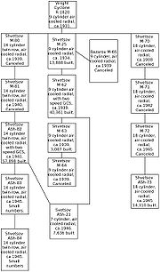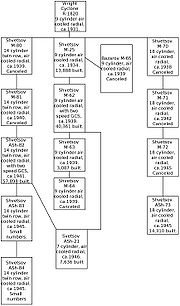
Shvetsov ASh-73
Encyclopedia
The Shvetsov ASh-73 was an 18-cylinder, air-cooled, radial aircraft engine
produced between 1947 and 1957 in the Soviet Union
. It was primarily used as the powerplant for the Tupolev Tu-4
heavy bomber, a copy of the American Boeing
B-29 Superfortress
.
Cyclone engine. Development continued through a series of less than successful engines, before culminating in the ASh-73. Contrary to popular belief the ASh-73 wasn't a reverse engineered copy of the Wright R-3350
: "There was no need to copy the Wright R-3350-23A; the engine that was put into production was the indigenous ASh-73TK - a further development of the M-71 and M-72, which differed in being fitted with twin TK-19 turbosuperchargers (TK = toorbokompressor)." rather the ASh-73 was the product of a similar specification. Since the earlier M-25 engines were a licensed copy of the Wright R-1820, there were similarities and some parts were interchangeable between the R-3350 and the ASh-73. The two engines evolved from a common ancestor and to a similar requirement. "In the late 1930s and the early 1940s OKB-19 evolved two 18-cylinder two-row radials — the 2,000-hp M-71 and the 2,250-hp M-72 — which were similar in their design features and production techniques to the Wright Duplex Cyclone engines powering the B-29."
The progenitor for the ASh-73 was the M-70. It was tested in late 1938 and was a failure because of cracks in the master connecting rod
and the geared centrifugal supercharger's impeller. The exhaust valves also burnt through. The M-71 of 1939 was the successor to the M-70 and it too was not a success. It used some components from the M-62
engine, but its development was slowed by the German attack on the Soviet Union in 1941. It passed its State acceptance tests in the autumn of 1942, but was not placed into production as there was not any production capacity available, although it was tested on a number of different prototypes during the war. The M-72 of early 1945 was a boosted version of the M-71 and was superseded by the ASh-73 before production could get underway.
The first prototypes of the ASh-73 were built in 1945 and by the end of 1946 testing had completed successfully. The first models to enter production in 1947 lacked turbo-superchargers. They weighed 1330 kg (2,932.1 lb) and had 2400 hp during take-off. The ASh-73TK had two TK-19 turbocharger
s and an intercooler
fitted which were direct copies of the units used on the R-3350. The engine was upgraded over the course of its production. On the fourth series of engines the crankshaft nose was changed, the articulated connecting rods were strengthened and the accessory drive was changed. The middle part of the crankcase and the pistons were strengthened and the ignition was improved in the fifth series. In the sixth series the master connecting rod and the crankshaft cheeks were strengthened, the pistons were lightened and shortened. For the seventh series exhaust valves with floating seats were introduced and the reduction gearing was improved.
A boosted version was developed as the ASh-82TKF that had a rating of 2720 hp. It was bench tested, but not put into production. A further development in 1949 was the ASh-73TKFN with fuel injection that boosted power to 2800 hp, but it too was not built. Another 1949 project was an ASh-73TK with a power-recovery turbine to create a turbo-compound engine
, but no other information is known.
Factory No. 19 began preparation to build the ASh-73 in 1946, but production did not begin until the next year. Production continued there until 1953. Factory No. 36 in Rybinsk also produced it until 1957. A total of 14,310 ASh-73s were built. A number of these were exported to the People's Republic of China
during the 1950s
as spare parts for their Tu-4s.

Aircraft engine
An aircraft engine is the component of the propulsion system for an aircraft that generates mechanical power. Aircraft engines are almost always either lightweight piston engines or gas turbines...
produced between 1947 and 1957 in the Soviet Union
Soviet Union
The Soviet Union , officially the Union of Soviet Socialist Republics , was a constitutionally socialist state that existed in Eurasia between 1922 and 1991....
. It was primarily used as the powerplant for the Tupolev Tu-4
Tupolev Tu-4
The Tupolev Tu-4 was a piston-engined Soviet strategic bomber that served the Soviet Air Force from the late 1940s to mid 1960s...
heavy bomber, a copy of the American Boeing
Boeing
The Boeing Company is an American multinational aerospace and defense corporation, founded in 1916 by William E. Boeing in Seattle, Washington. Boeing has expanded over the years, merging with McDonnell Douglas in 1997. Boeing Corporate headquarters has been in Chicago, Illinois since 2001...
B-29 Superfortress
B-29 Superfortress
The B-29 Superfortress is a four-engine propeller-driven heavy bomber designed by Boeing that was flown primarily by the United States Air Forces in late-World War II and through the Korean War. The B-29 was one of the largest aircraft to see service during World War II...
.
Design and development
The Shvetsov ASh-73 originated in 1938 from a specification for a 18-cylinder, twin-row, development of the Shvetsov M-25, a license-built 9-cylinder, air-cooled, radial Wright R-1820-F3Wright R-1820
|-See also:-References:* Bridgman, L, Jane's Fighting Aircraft of World War II. Crescent. ISBN 0-517-67964-7* Eden, Paul & Soph Moeng, The Complete Encyclopedia of World Aircraft. Amber Books Ltd. Bradley's Close, 74-77 White Lion Street, London, NI 9PF, 2002, ISBN 0-7607-3432-1), 1152...
Cyclone engine. Development continued through a series of less than successful engines, before culminating in the ASh-73. Contrary to popular belief the ASh-73 wasn't a reverse engineered copy of the Wright R-3350
Wright R-3350
The Wright R-3350 Duplex-Cyclone was one of the most powerful radial aircraft engines produced in the United States. It was a twin row, supercharged, air-cooled, radial engine with 18 cylinders. Power ranged from 2,200 to over 3,700 hp , depending on the model...
: "There was no need to copy the Wright R-3350-23A; the engine that was put into production was the indigenous ASh-73TK - a further development of the M-71 and M-72, which differed in being fitted with twin TK-19 turbosuperchargers (TK = toorbokompressor)." rather the ASh-73 was the product of a similar specification. Since the earlier M-25 engines were a licensed copy of the Wright R-1820, there were similarities and some parts were interchangeable between the R-3350 and the ASh-73. The two engines evolved from a common ancestor and to a similar requirement. "In the late 1930s and the early 1940s OKB-19 evolved two 18-cylinder two-row radials — the 2,000-hp M-71 and the 2,250-hp M-72 — which were similar in their design features and production techniques to the Wright Duplex Cyclone engines powering the B-29."
The progenitor for the ASh-73 was the M-70. It was tested in late 1938 and was a failure because of cracks in the master connecting rod
Connecting rod
In a reciprocating piston engine, the connecting rod or conrod connects the piston to the crank or crankshaft. Together with the crank, they form a simple mechanism that converts linear motion into rotating motion....
and the geared centrifugal supercharger's impeller. The exhaust valves also burnt through. The M-71 of 1939 was the successor to the M-70 and it too was not a success. It used some components from the M-62
Shvetsov ASh-62
-Bibliography:* * -External links:***...
engine, but its development was slowed by the German attack on the Soviet Union in 1941. It passed its State acceptance tests in the autumn of 1942, but was not placed into production as there was not any production capacity available, although it was tested on a number of different prototypes during the war. The M-72 of early 1945 was a boosted version of the M-71 and was superseded by the ASh-73 before production could get underway.
The first prototypes of the ASh-73 were built in 1945 and by the end of 1946 testing had completed successfully. The first models to enter production in 1947 lacked turbo-superchargers. They weighed 1330 kg (2,932.1 lb) and had 2400 hp during take-off. The ASh-73TK had two TK-19 turbocharger
Turbocharger
A turbocharger, or turbo , from the Greek "τύρβη" is a centrifugal compressor powered by a turbine that is driven by an engine's exhaust gases. Its benefit lies with the compressor increasing the mass of air entering the engine , thereby resulting in greater performance...
s and an intercooler
Intercooler
An intercooler , or charge air cooler, is an air-to-air or air-to-liquid heat exchange device used on turbocharged and supercharged internal combustion engines to improve their volumetric efficiency by increasing intake air charge density through nearly isobaric cooling, which removes...
fitted which were direct copies of the units used on the R-3350. The engine was upgraded over the course of its production. On the fourth series of engines the crankshaft nose was changed, the articulated connecting rods were strengthened and the accessory drive was changed. The middle part of the crankcase and the pistons were strengthened and the ignition was improved in the fifth series. In the sixth series the master connecting rod and the crankshaft cheeks were strengthened, the pistons were lightened and shortened. For the seventh series exhaust valves with floating seats were introduced and the reduction gearing was improved.
A boosted version was developed as the ASh-82TKF that had a rating of 2720 hp. It was bench tested, but not put into production. A further development in 1949 was the ASh-73TKFN with fuel injection that boosted power to 2800 hp, but it too was not built. Another 1949 project was an ASh-73TK with a power-recovery turbine to create a turbo-compound engine
Turbo-compound engine
A turbo-compound engine is a reciprocating engine that employs a blowdown turbine to recover energy from the exhaust gases. The turbine is usually mechanically connected to the crankshaft but electric and hydraulic systems have been investigated as well. The turbine increases the output of the...
, but no other information is known.
Factory No. 19 began preparation to build the ASh-73 in 1946, but production did not begin until the next year. Production continued there until 1953. Factory No. 36 in Rybinsk also produced it until 1957. A total of 14,310 ASh-73s were built. A number of these were exported to the People's Republic of China
People's Republic of China
China , officially the People's Republic of China , is the most populous country in the world, with over 1.3 billion citizens. Located in East Asia, the country covers approximately 9.6 million square kilometres...
during the 1950s
1950s
The 1950s or The Fifties was the decade that began on January 1, 1950 and ended on December 31, 1959. The decade was the sixth decade of the 20th century...
as spare parts for their Tu-4s.
Applications
- Beriev Be-6Beriev Be-6|-See also:-References:* Gunston, Bill. “The Osprey Encyclopaedia of Russian Aircraft 1875 – 1995”. London, Osprey. 1995. ISBN 1-85532-405-9* Gordon,Yefim & Komissarov, Dmitry. Chinese Aircraft. Hikoki Publications. Manchester. 2008. ISBN 9 781902 109046...
- Ilyushin Il-18 (1947)
- Tupolev Tu-4Tupolev Tu-4The Tupolev Tu-4 was a piston-engined Soviet strategic bomber that served the Soviet Air Force from the late 1940s to mid 1960s...
- Tupolev Tu-70Tupolev Tu-70|-See also:...
- Tupolev Tu-75Tupolev Tu-75|-See also:-References:NotesBibliography...
- Tupolev Tu-80Tupolev Tu-80|-See also:-References:...
Specifications (Shvetsov ASh-73TK)


